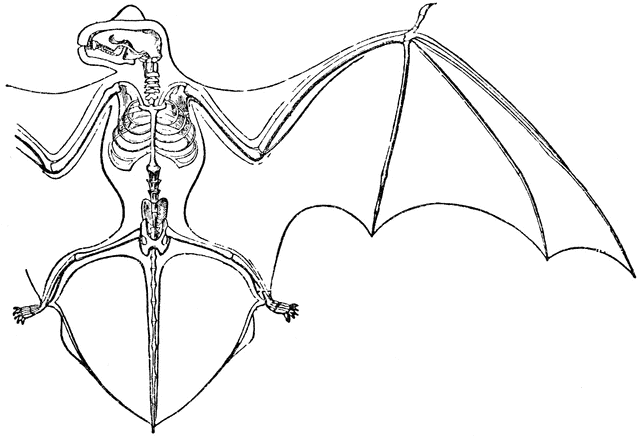![]()
La selección natural lucha con la tendencia a la reversión y la variabilidad y otras falacias en el párrafo ducentésimo vigésimo octavo de El Origen de las Especies

La selección natural no solo es lucha por la supervivencia y supervivencia del más apto. A su vez la selección natural lucha con otros factores como la tendencia a reversión y la variabilidad, se nos informa en este complicado párrafo en el que el autor regresa a la naturaleza para mencionar el ala del murciélago como ejemplo de órgano extraordinariamente desarrollado.
Al principio del párrafo un razonamiento característico del autor en el que la conclusión va incluida ya en la premisa. No se la pierdan:
When a part has been developed in an extraordinary manner in any one species, compared with the other species of the same genus, we may conclude that this part has undergone an extraordinary amount of modification since the period when the several species branched off from the common progenitor of the genus.
A continuación ambigüedad en estado puro:
This period will seldom be remote in any extreme degree, as species rarely endure for more than one geological period.
Seguidamente una combinación de ambas: Ambigüedad e inclusión de conclusiones en la premisa:
An extraordinary amount of modification implies an unusually large and long-continued amount of variability, which has continually been accumulated by natural selection for the benefit of the species.
228
Now let us turn to nature. When a part has been developed in an extraordinary manner in any one species, compared with the other species of the same genus, we may conclude that this part has undergone an extraordinary amount of modification since the period when the several species branched off from the common progenitor of the genus. This period will seldom be remote in any extreme degree, as species rarely endure for more than one geological period. An extraordinary amount of modification implies an unusually large and long-continued amount of variability, which has continually been accumulated by natural selection for the benefit of the species. But as the variability of the extraordinarily developed part or organ has been so great and long-continued within a period not excessively remote, we might, as a general rule, still expect to find more variability in such parts than in other parts of the organisation which have remained for a much longer period nearly constant. And this, I am convinced, is the case. That the struggle between natural selection on the one hand, and the tendency to reversion and variability on the other hand, will in the course of time cease; and that the most abnormally developed organs may be made constant, I see no reason to doubt. Hence, when an organ, however abnormal it may be, has been transmitted in approximately the same condition to many modified descendants, as in the case of the wing of the bat, it must have existed, according to our theory, for an immense period in nearly the same state; and thus it has come not to be more variable than any other structure. It is only in those cases in which the modification has been comparatively recent and extraordinarily great that we ought to find the GENERATIVE VARIABILITY, as it may be called, still present in a high degree. For in this case the variability will seldom as yet have been fixed by the continued selection of the individuals varying in the required manner and degree, and by the continued rejection of those tending to revert to a former and less modified condition.
Volvamos ahora a la naturaleza. Cuando una parte se ha desarrollado de un modo extraordinario en una especie, en comparación con las otras especies del mismo género, podemos sacar la conclusión de que esta parte ha experimentado extraordinaria modificación desde el período en que las diferentes especies se separaran del tronco común del género. Este período pocas veces será extremadamente remoto, pues las especies rara vez persisten durante más de un período geológico. Modificaciones muy grandes implican variabilidad grandísima, muy continuada, que se ha ido acumulando constantemente por selección natural para beneficio de la especie. Pero como la variabilidad del órgano o parte extraordinariamente desarrollados ha sido tan grande y continuada dentro de un período no demasiado remoto, tenemos que esperar encontrar todavía, por regla general, más variabilidad en estas partes que en otras del organismo que han permanecido casi constantes durante un período mucho más largo, y yo estoy convencido de que ocurre así. No veo razón para dudar de que la lucha entre la selección natural, de una parte, y la tendencia a la reversión y la variabilidad, de otra, cesarán con el transcurso del tiempo, y que los órganos más extraordinariamente desarrollados pueden hacerse constantes. Por consiguiente, cuando un órgano, por anómalo que sea, se ha transmitido, aproximadamente en el mismo estado, a muchos descendientes modificados, como en el caso del ala del murciélago, tiene que haber existido, según nuestra teoría, durante un inmenso período, casi en el mismo estado, y de este modo, ha llegado a no ser más variable que cualquier otra estructura. Sólo en estos casos, en los cuales la modificación ha sido relativamente reciente y extraordinariamente grande, debemos esperar encontrar la variabilidad generativa, como puede llamársele, presente todavía en sumo grado, pues, en este caso, la variabilidad raras veces habrá sido fijada todavía por la selección continuada de los individuos que varíen del modo y en el grado requeridos y por la exclusión continuada de los que tiendan a volver a un estado anterior y menos modificado.
